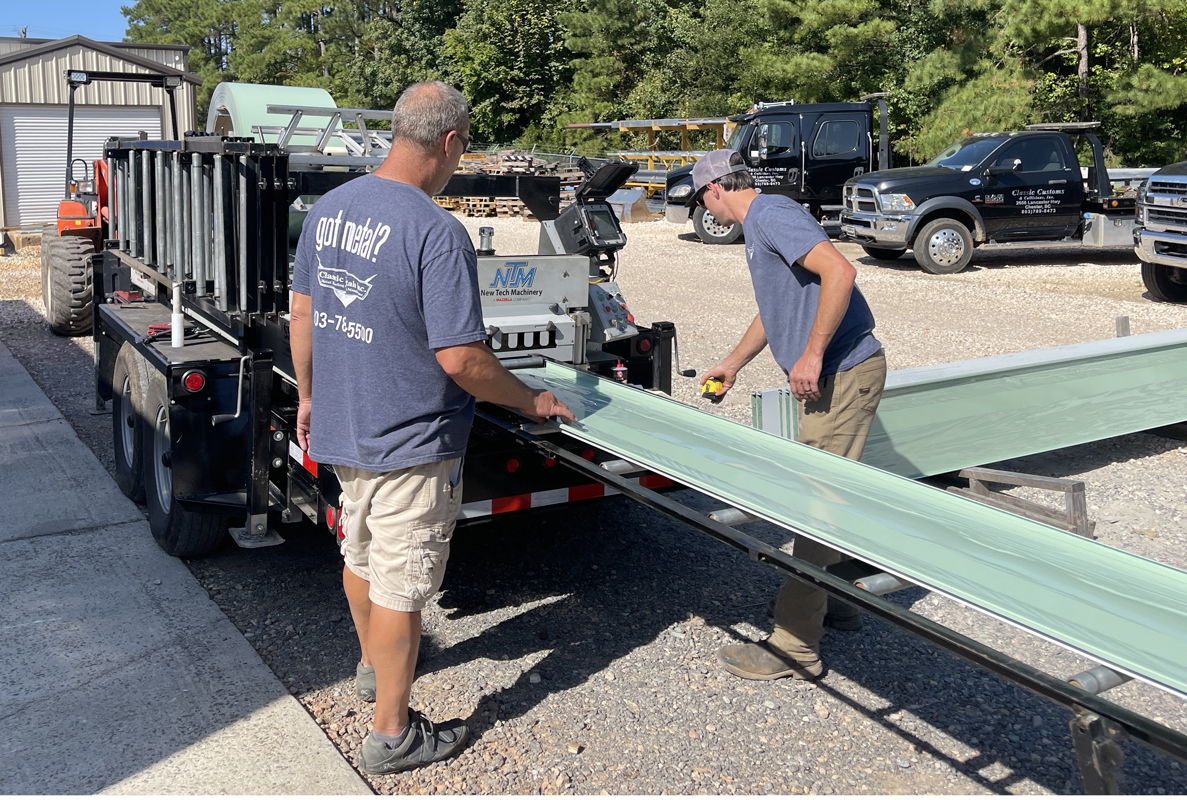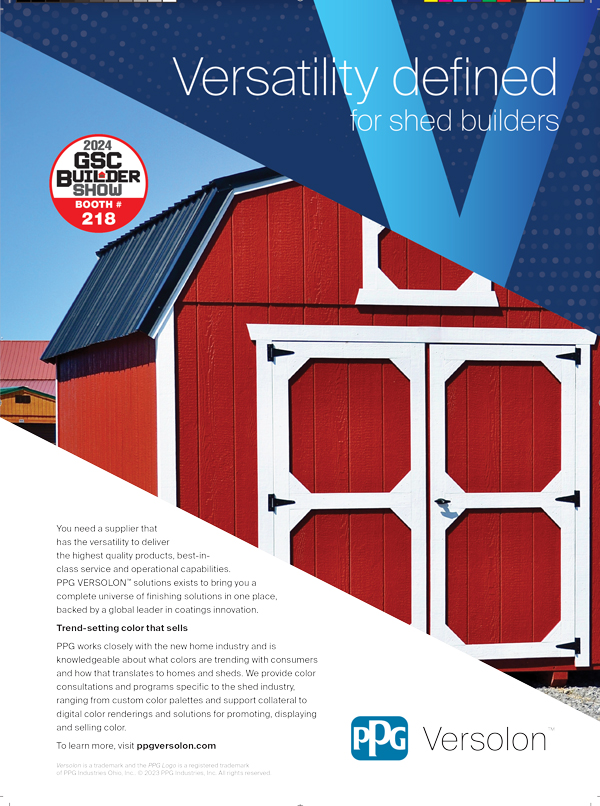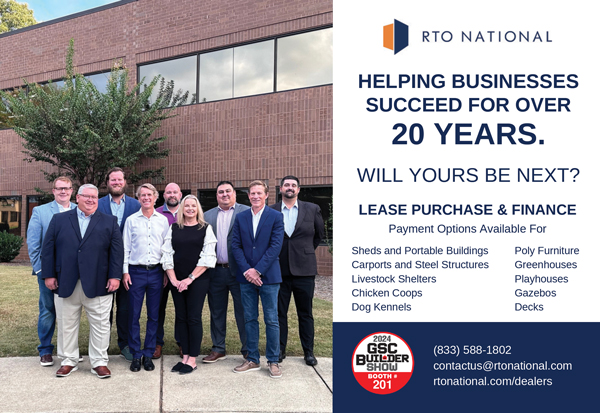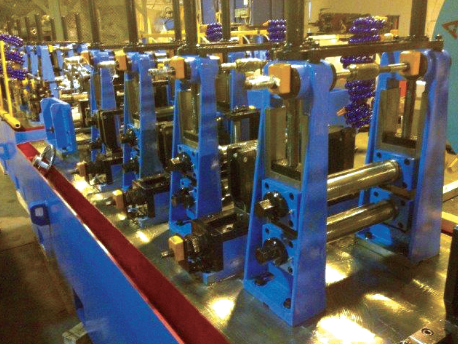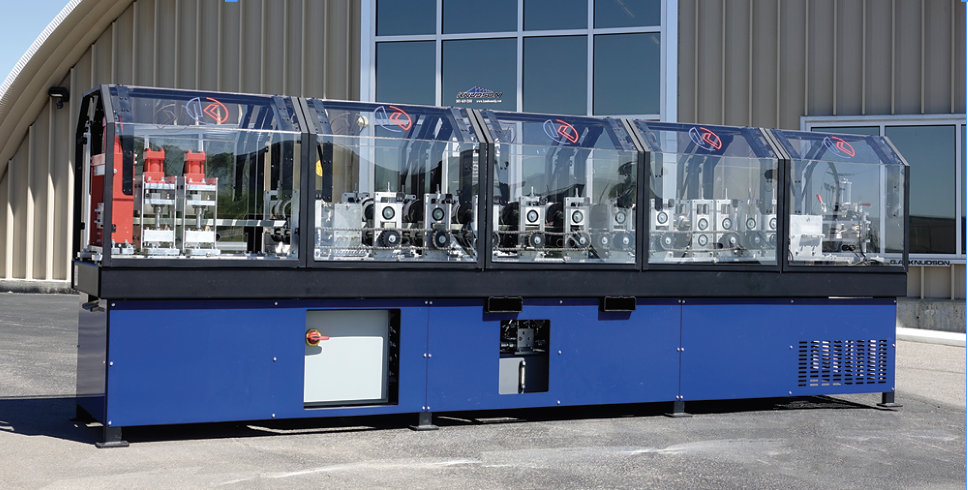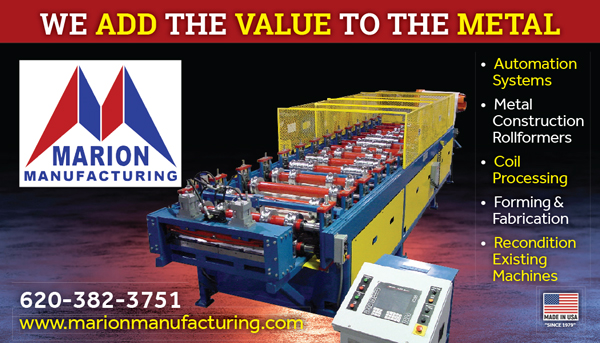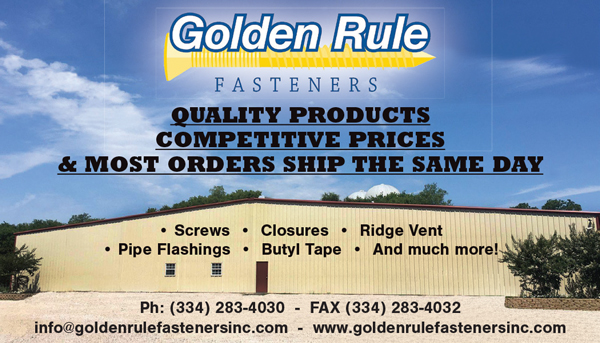By Dan Brownell
One of the most stressful times for a small business owner occurs when faced with making a major financial decision. Sometimes a fork in the road comes after success and growth. At a certain point, an owner must determine whether to take a risk and make an investment for further growth or remain at the current size.
Delving into roll forming is one of those opportunities for growth that requires a financial risk. Purchasing a roll former, even a used one, can require a very large investment, but as Wayne Troyer, of Acu-Form explained, not investing in growth presents its own set of risks. Having to rely on a manufacturer to provide roll-formed metal has significant disadvantages. For example, a builder may not be able to get the finished metal required for a job as quickly as needed. In some cases, a custom order may not be available at all because there’s just not enough demand for that specific product for a manufacturer to make it worth producing in small quantities.
Owning a roll former allows a builder to create finished product that’s ready when needed, in whatever gauge, quantity, size, shape, and color required. Also, damaged or defective pieces can be replaced immediately rather than having to wait for a reorder to be shipped. It also allows builders to quickly produce roll-formed metal that wasn’t planned for in an initial order. That flexibility cuts down on costly building delays.
Having a roll former that’s portable has additional advantages. Since standard semis are 53’ long, they can’t transport panels longer than that. A portable roll former allows a builder to roll panels on site, which means the panels can be as long as needed. Plus, since panels are cut as needed, it reduces waste, downtime between jobs, and damage to panels caused by shipping or being stored on the jobsite.
Potential Return on Investment
Builders who do their own roll forming can save a lot of money compared to buying preformed metal from a factory supplier. Tom Laird of New Tech Machinery said, “We’ve done a number of payback studies over the years, and they show that, in a perfect world where the factory supplier is giving you everything exactly as it’s supposed to be, and there’s no freight damage, they’re not late, there’s no shortages of panels, and no wrong lengths, you’re going to save between 10% and 35% on costs, depending on the size and scope of the project.” And that’s in a perfect world. Savings can be even greater because in the real world, those supplier problems do occur. “When that happens, these guys are down, they can’t finish their job, and they can’t get paid. But if you have your own machine, it’s basically ‘metal on demand.’ You just need to find a coil supplier, get the color and gauge and width of material you need, and you’re running.”
When Is the Right Time for a Builder to Start Rollforming?
Given the large investment required for a roll former, when is it the right time for a business to take that step? Troyer said, “The time is right when it costs you more not to have one.” If you’re losing too many contracts, or you’re losing too much time waiting or paying too much markup for finished panels, then it may be time to consider doing your own roll forming. Troyer said it’s a good idea to discuss the investment with an accountant who can help run the numbers.
One thing to keep in mind, he added, is that after making the investment, there’s likely to be a period in which the business is initially losing more than gaining. But what typically happens is that very quickly a builder will start getting requests from other local builders to supply roll-formed metal for their projects. That provides additional revenue to offset the debt. But the demand from other builders can grow to the point where it can take too much time and too many resources away from the builder’s own more-profitable building business. So Troyer cautions builders who are starting a roll forming business to carefully balance those two sides of the business to maximize efficiency and profit.
Sometimes, Troyer said, when a builder just isn’t ready to make the leap into roll forming, he will buy a brake and/or a few trim machines to make his trim and still buy the panels elsewhere, then work his way up.
Estimating Total Investment Costs
It’s important for a builder to consider total costs because he will need more than just a roll forming machine. He’ll need a significant amount of coil inventory as well. Frank Schiene of Metal Rollforming Systems said, “We try to help prospective customers estimate inventory costs up front, so we help with their projections. A lot of people think the machine is the only expensive part and they don’t realize how much inventory they’ll need to have.
Schiene said he has a cost analysis program he can use to help builders figure out the breakeven point. “They can plug in numbers and then say, “Well, this is what I would need for return on investment and estimate upfront cost versus what potential growth is.” We want builders to be successful because, honestly, if they’re not successful, neither are we.”
Look Before You Leap
Schiene’s most important piece of advice is, “Don’t just jump in. Do your homework first. Check your area demographically. Find out what you’re facing. Use people that have been in an industry for a long time who can help you. Find out all aspects of the business, go to a trade show, talk around, and ask people for referrals on anybody you’re looking into. If you have a list of people, call them, call every one of them. That way you can find out about a company and do your homework before you find out that cheaper is not always better. And not every company, even a good one, will be a good fit. Some companies will have equipment that’s better suited to a particular need.”
Think About Your Current and Future Market
When contemplating investing in a roll former, it’s important to consider where you plan on going with your business in the future as well as what your needs are right now. Laird said, “If builders doe strictly residential work, and they never see themselves morphing in any sort of commercial work, then they might be able to get a more affordable machine. They can look at a machine that might not have all the bells and whistles that the bigger machines have, but they won’t need them. But a lot of times the guys we deal with who bought a smaller machine come back to us within a few years and say, ‘I wish I would have bought the big one because I’ve had to turn down work.’”
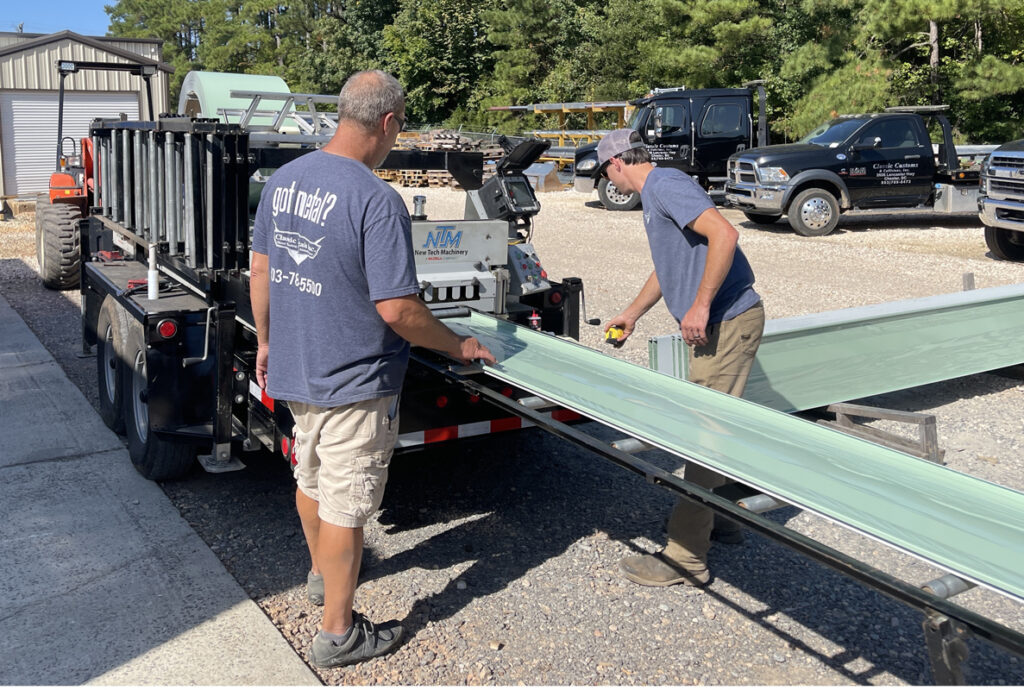
Classic Metals operating machine.
Photo courtesy of New Tech Machinery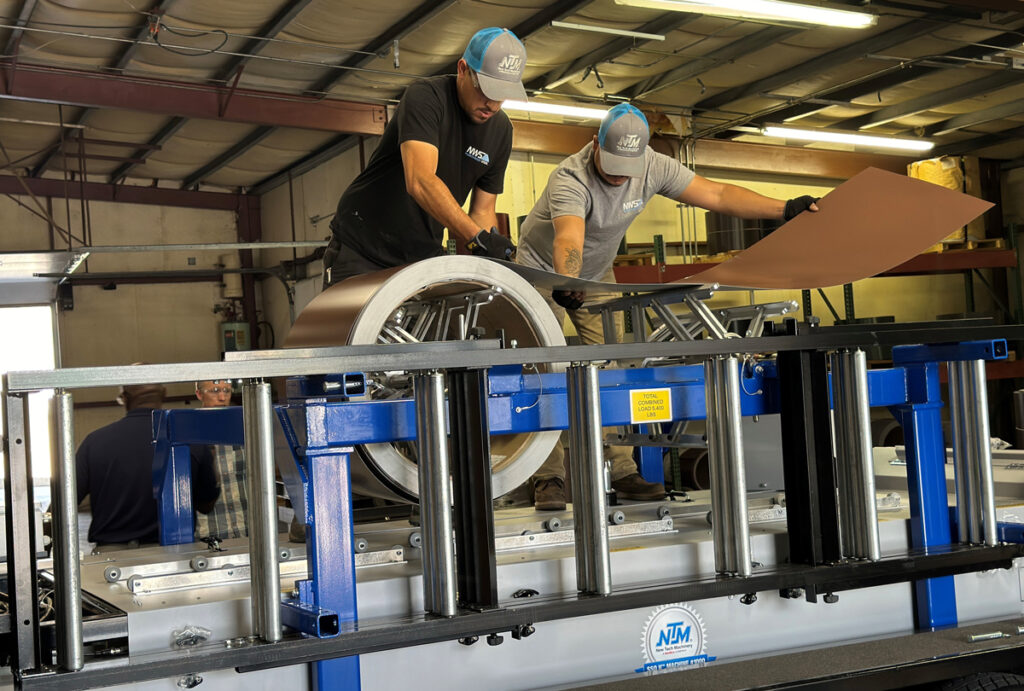
Loading coil. Photo courtesy
of New Tech Machinery
Another thing Laird said to consider is how versatile you need your machine to be. “Some guys just do residential roofing and that’s it,” he said. “Some guys do residential and commercial, plus they also want to dabble in doing wall panels. Our biggest machine is capable of doing board and batten and flush wall/soffit panel profiles. So if they see themselves being able to do siding or under decking panels in the future, things like that, that might dictate what machine they want to look at because while the initial machine investment may be higher, in the long run, it’s going to benefit you because you’re not going to need multiple machines to do different panels.”
Purchasing a Roll Former
For those builders ready to get started in the roll forming business, there are a couple of payment options. One is to finance a purchase through a bank or a roll-former manufacturing company. according to Section179.org, there are tax benefits to purchasing a machine. The organization’s site states, “Essentially, Section 179 of the IRS tax code allows businesses to deduct the full purchase price of qualifying equipment and/or software purchased or financed during the tax year. That means that if you buy (or lease) a piece of qualifying equipment, you can deduct the FULL PURCHASE PRICE from your gross income. It’s an incentive created by the U.S. government to encourage businesses to buy equipment and invest in themselves.” (section179.org/section_179_deduction)
Leasing a Rollformer
Another option is to lease a machine. Here’s what
bankofamerica.com says:
• You save big by leasing with pre-tax dollars
Let’s assume your business has plenty of cash on hand to acquire vehicles or equipment. When you make a purchase, you’re paying with post-tax dollars: That $60,000 item may cost you as much as $80,000 or $90,000 (depending on your specific tax situation). Why? Because your business needs that greater pre-tax income to net the $60,000 needed to make the purchase. When you lease, though, you’re doing so with pre-tax dollars: That $60,000 purchase costs your business $60,000 and your lease payments can be written off as a business expense.
• Leasing won’t give you depreciation deductions
When your business owns a vehicle or piece of equipment, the business can take a tax deduction for the depreciation in value of that vehicle or equipment over the life of the item. When your business leases the same item, though, the depreciation deduction is not allowed.
• But leasing may get you Section 179 tax advantages
Section 179 of the Internal Revenue Code allows you to fully deduct the cost of some newly purchased assets in the first year — but your company can also lease and still take full advantage of the Section 179 deduction. Be aware, though, that Section 179 can change each year (or even mid-year) without notice — which makes the next paragraph the most important one on this page.
• Be sure to speak with a tax professional
Every business is different. Tax laws vary from state to state. Tax laws are revised regularly. It’s complicated stuff. Your best course of action? Do your research — then speak with a tax professional to understand all the financial implications before you make your decision.”
(bankofamerica.com/smallbusiness/business-financing/learn/understanding-tax-implications-of-leasing)
Facility Space
Whether you’re purchasing a stationary or portable roll former, you’ll need an adequate amount of enclosed facility space to house the equipment and coil inventory. Make sure you account for vehicle access and movement and that service doors are high enough and wide enough.
New or Used?
Like vehicles, used machines will be less expensive than new, but used machines will have wear and tear that can cause breakdowns, lost time, lost profit, and frustrated customers because of delays in the project. Used machines will likely need more periodic maintenance, which will also add additional expense and possibly additional downtime. Also, warranties will be shorter and cover less. Some may not have a warranty at all.
It may be best to consider comparing estimated annual total costs of ownership for new and used options. The additional costs of a used machine from increased maintenance, decreased production, and decreased profits could cancel out savings made from the lower initial cost of buying a used roll former. If you do plan to buy a used machine, be sure to inspect it carefully, ask to test it, make sure replacement parts and software updates are available, and check the fine print on the warranty.
Demand, Availability, and Lead Time for a Roll-Former Machine
New roll formers are in high demand, and there may not be many (or any) used machines immediately available either, so plan for a long wait once you place your order. Make that time count by doing as much planning, training, and marketing work as possible in advance.
Training and Maintenance
Most reputable roll-former companies provide training for their machines, either in the field or in the factory. Training is essential because employees need to know how to run the controls, adjust the machines, troubleshoot, do basic preventive maintenance, and operate the equipment safely.
Laird said, “Make sure the owner or somebody on their staff has mechanical competence because if they’re going to own their own piece of equipment, they need to know how to troubleshoot, service, and adjust it. Just like just like owning a car or anything else that’s going to require some level of maintenance, and particularly if you’re running multiple panel profiles, you’re going to be changing panels inside the machine. You need to understand the ins and outs of how all that works.”
Choosing a Rollformer Company
Builders who want to purchase or lease a machine should do their due diligence by researching roll former companies thoroughly to assess their quality and reliability. This includes their warranties, training, service, and parts support.
Finding a Reliable Coil Supplier
Laird explained that it’s crucial to have a trusted coil supplier. The big well-known suppliers have their own testing and will provide that documentation for wind uplift, water infiltration, air penetration, foot traffic, etc. “Those are typically more on the commercial side than the residential side,” he said. “But when you get into Florida, you’re going to have higher velocity hurricane zones, and you’re going to have Miami-Dade County testing. There’s other more stringent testing depending on the region of the country you work in. If you’re going to be making your own panels, you’re going to want to align yourself with a quality coil supplier, one that’s going to be able to offer assistance and backing when it comes to that sort of thing.
Conclusion
Getting into rollforming is a big jump because of the substantial investment, but by teaming up with a reputable roll-forming equipment sales representative and an accountant, you can develop a business plan and a picture of the potential risk versus return on investment to help you make an informed decision. GSCB


